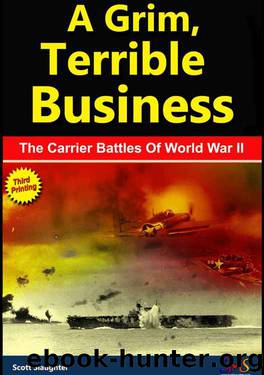A Grim, Terrible Business: The Carrier Battles Of World War II by Scott Slaughter

Author:Scott Slaughter [Slaughter, Scott]
Language: eng
Format: epub
Publisher: Scott Slaughter
Published: 2013-05-16T21:00:00+00:00
The Final Road To Tokyo Wasn’t Easy
Although much fighting and destruction was still to come, the war began to change in the late summer and early fall 1943 when the U.S. Navy began flying three new aircraft and using a new class of aircraft carriers.
When the F6F Hellcat, Grumman’s successor to its F4F Wildcat fighter, began to appear in increasing numbers throughout late summer 1943, the U.S. Navy had a truly remarkable aircraft to take on the Japanese Zero. The big, powerful, angular fighter could outperform and outclass F4F Wildcat in virtually all areas particularly in the three most important areas of speed, rate of climb and range. Perhaps the one statistic that proved the greatness of the F6F Hellcat was that it produced more aces – more than 300 – than any other fighter in U.S. military history
Grumman and other factories licensed to manufacture the aircraft built more than 12,000 F6F aircraft in less than three years.
Another aircraft that played a critical role for the U.S. Navy was the Curtiss SB2C Helldiver. It was bigger and faster than the SBD Dauntless and by mid-1944 had replaced the Dauntless. Although the Helldiver had some serious problems after its introduction, U.S. Navy squadrons eagerly accepted it by the end of the war.
The third aircraft was Chance Vought’s elegant F4U Corsair. It was the last U.S. carrier fighter introduced to combat during World War II but the aircraft made its early reputation with the U.S. Marine Corps squadrons, especially in the Solomons. Marine Squadron VF-17, under the command of Lieutenant Commander Tom Blackburn, in particular, had tremendous success with the new aircraft. Marine Corsairs augmented Navy air groups beginning in late 1944 and by war’s end the F4U rivaled the F6F in U.S. carrier service.
One reason the Corsair made its early reputation with the U.S. Marine Corps squadrons was that its poor landing characteristics forced the U.S. Navy initially to ban the Corsair from carrier service,
It wasn’t only new, more powerful aircraft that made a difference for the U.S. Navy in the Pacific Theatre but it was also the introduction of two classes of fast carriers. The Essex-class carriers carried about 3,000 men, were larger, displacing 27,100-tons, and faster, 33 knots, than the earlier carriers in World War II. Pilots would quickly appreciate their 872-foot flight deck. They were capable of handling eighty or more aircraft and had new design features such as deck side elevators to move the aircraft quicker off the flight deck.
The Essex-class carriers also featured new state-of-art combat information centers full of several radar screens and radios. In the event of a successful enemy attack, the carriers had new fire-fighting equipment that let damage control parties use new strategies and methods to fight fires and help any of the Essex-class carriers from being sunk.
Not every new piece of equipment was bigger because the U.S. Navy also started using its 11,000-ton light aircraft carriers (CVL) that were converted from cruiser hulls. The CVLs could carry no more than 33 aircraft but they could move much faster than the Essex-class carriers.
Download
This site does not store any files on its server. We only index and link to content provided by other sites. Please contact the content providers to delete copyright contents if any and email us, we'll remove relevant links or contents immediately.
The Vikings: Conquering England, France, and Ireland by Wernick Robert(79865)
Ali Pasha, Lion of Ioannina by Eugenia Russell & Eugenia Russell(40133)
The Conquerors (The Winning of America Series Book 3) by Eckert Allan W(37103)
The Vikings: Discoverers of a New World by Wernick Robert(36906)
Cecilia; Or, Memoirs of an Heiress — Volume 1 by Fanny Burney(32410)
Cecilia; Or, Memoirs of an Heiress — Volume 3 by Fanny Burney(31817)
Cecilia; Or, Memoirs of an Heiress — Volume 2 by Fanny Burney(31794)
Empire of the Sikhs by Patwant Singh(22959)
The Secret History by Donna Tartt(18803)
Hans Sturm: A Soldier's Odyssey on the Eastern Front by Gordon Williamson(18453)
Cat's cradle by Kurt Vonnegut(15145)
Pimp by Iceberg Slim(14311)
Sapiens: A Brief History of Humankind by Yuval Noah Harari(14209)
Talking to Strangers by Malcolm Gladwell(13183)
Norse Mythology by Gaiman Neil(13167)
Leonardo da Vinci by Walter Isaacson(13144)
4 3 2 1: A Novel by Paul Auster(12260)
Underground: A Human History of the Worlds Beneath Our Feet by Will Hunt(11996)
The Radium Girls by Kate Moore(11896)
